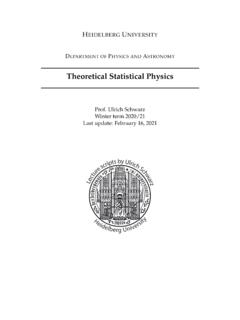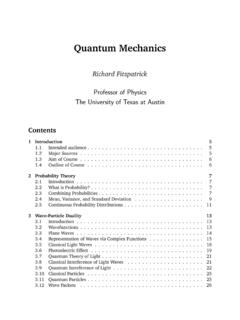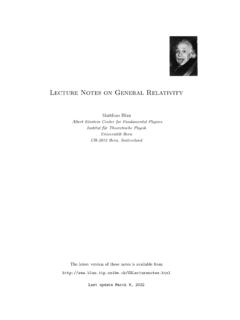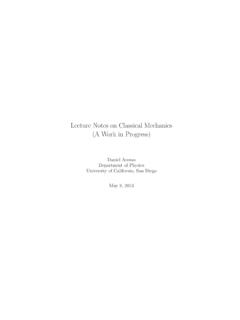Transcription of Lecture notes: Cosmology
1 Lecture notes : CosmologyLuca AmendolaUniversity of 31, 2023 ContentsI The homogeneous Universe51 A short history of cosmology62 Introduction to special relativity .. Metric and gravitation .. Covariant derivative .. The FLRW metric .. Hubble law .. Redshift .. General relativity equations .. Energy-momentum tensor .. The curvature tensor .. Hilbert-Einstein Lagrangian .. Spatial curvature of FRW .. Natural units and Planck units .. 203 The expanding Friedmann equations .. Non relativistic component .. Relativistic component .. General component .. General Friedmann equation .. Qualitative trends .. Cosmological constant .. Cosmological observations .. Luminosity distance .. 284 Thermal Preliminaries .. The abundance of cosmic neutrinos .. Primordial nucleosynthesis.
2 Primordial nucleosynthesis, more details .. Matter-radiation decoupling .. 395 The distance The parallax method .. Cepheids .. Planetary nebulae .. Surface Brightness Fluctuations .. Tully-Fisher relation and the Fundamental Plane .. Supernovae Ia .. 441 CONTENTS26 Accelerated SNIa at high redshiftsa.. Models of dark energy .. 527 Cosmic A short history of the Universe .. The problems of the standard model .. Old inflation and scalar field dynamics .. Slow rolling .. 61II The perturbed Universe638 Linear The Newtonian equations .. Introduction to the relativistic treatment .. The fluctuation equations .. The Newtonian gauge .. Scales larger than the horizon .. Newtonian limit & the Jeans length .. Perturbation evolution .. Two-fluids solution .. Growth rate and growth function in CDM.
3 769 Correlation function and power Why we need correlation functions, power spectra and all that .. Average, variance, moments.. Definition of the correlation function .. Measuring the correlation function in real catalog .. Correlation function: examples .. The angular correlation function .. The n-point correlation function and the scaling hierarchy .. The power spectrum .. From the power spectrum to the moments .. 8610 Origin of inflationary From a harmonic oscillator to field quantization .. Scalar perturbations .. 9311 The Cosmic Microwave A short history of the CMB research .. Anisotropies on the cosmic microwave background .. The CMB power spectrum .. The Sachs-Wolfe effect .. The baryon acoustic peaks .. The small angular scales .. Reionization and other line-of-sight effects.. Foregrounds.
4 Polarization .. codes .. 104aAdapted from Amendola & Tsujikawa,Dark Energy. Theory and Observations, CUP The galaxy power Large scale structure .. The bias factor .. Normalization of the power spectrum .. The peculiar velocity field .. The redshift distortion .. Baryon acoustic oscillations .. Non-linear correction .. The Euclid satellite .. 11913 Weak Convergence and shear .. Ellipticities and systematics .. The shear power spectrum .. Current results .. 126 III Galaxies and Clusters12714 Non-linear perturbations: simplified The Zel dovich approximation .. Spherical collapseb.. The mass function of collapsed objectsc.. 13215 Measuring mass in stars and Mass of starsd.. Mass of galaxies .. Halo profiles .. Galaxy luminosity function .. 14116 Cosmology with galaxy Quick summary .. Mass of clusters .. Baryon fractione.
5 Virial theorem .. The abundance of clustersf.. Sunyaev-Zel dovich effect .. 14917 Observing the diffused The 21cm line and the epoch of reionization .. Lyman- forest .. 15818 Dark Dark matter candidates .. Direct detection .. Indirect detection .. The problems of the cold dark matter .. 162 Appendix164bAdapted from Amendola & Tsujikawa,Dark Energy. Theory and Observations, CUP from Amendola & Tsujikawa,Dark Energy. Theory and Observations, CUP section follows closely the treatment of Prof. Bartelmann s Lecture from Amendola & Tsujikawa,Dark Energy. Theory and Observations, CUP from Amendola & Tsujikawa,Dark Energy. Theory and Observations, CUP and creditsThis course is addressed to master students; there are no special pre-requisites although often we will makeuse of concepts from General relativity and some basic astronomy.
6 All the concepts will be introduced in aself-consistent way but clearly the student will benefit a lot by reading the relevant chapters in the followingtexts and in astrophysics readings:S. Dodelson,Modern Cosmology , Academic Press (my favourite)L. Amendola & S. Tsujikawa,Dark Energy. Theory and Observations, CUP (more advanced material)D. Baumann, Cosmology ( )O. Piattella, Lecture notes in Cosmology , Springer (recent and complete)M. Bartelmann,Observing the Big Bang, Lecture notesM. Bartelmann, Cosmology , Lecture notesFor a quick (24 pages) but complete introduction to GR:S. Carroll,A no-nonsense introduction to GR, specialized texts:N. Sugiyama,Introduction to temperature anisotropies of CMB, PTEP,2014, 06B101D. Weinberg et al.,Observational probes of cosmic acceleration, figures in this text are either created by the Author or used with permission or believedto be in the public domain.
7 If there is any objection to the use of any material, please let meknow. The text is released under CC license ( )that is, it is free for non-commercial use, provided appropriate credit is given. I cannot guaranteethat also the figures are covered by this IThe homogeneous Universe5 Chapter 1A short history of Cosmology In 1917, Einstein publishes the first cosmological model, based on the introduction of the cosmologicalconstant and on assuming homogeneity and isotropy. Einstein s model was static (later it was shownhowever that this static model is unstable). in 1918, de Sitter shows that a Universe dominated by the cosmological constant would be expanding. in 1922, Alexander Friedmann solves Einstein s cosmological equations with and without the cosmologicalconstant, showing they generically allow for a dynamic Universe ( expanding or contracting) obeyingwhat was later called Hubble s law.
8 In 1927, Lemaitre discovers independently this general cosmologicalmodel and makes it well known among the community. Lemaitre was the first to actually formulate Hubblelaw explicitly and evaluate the Hubble constant from the then available data. in 1929 Edwin Hubble discovers the cosmic expansion obeying Hubble s law, after several years of pioner-istic work by himself and by several other scientists: Milton Humason, Henrietta Leavitt, Vesto Slipher,and others. Hubble constant, whose inverse gives the time scale for the expansion, was found to be around 600 km/sec,almost ten times larger than the currently accepted value. With this constant, the Universe would be acouple billion years old, too short to allow for star evolution. In the 30s, Fritz Zwicky postulates the existence of a large component of dark matter to explain thevelocities of the galaxis within the Coma cluster.
9 After the second WW, Gamow and collaborators investigate the physics of a hot big-bang Universe andformulate definite predictions about primordial nucleosynthesis and the cosmic microwave background. In 1965, Penzias and Wilson discover the 3K cosmic microwave background radiation (CMB), interpretedby R. Dicke and collaborators as the relic of the hot primordial phase. This practically ruled out thealternative steady-state cosmological model proposed by Hoyle and colaborators in the 50s. In the same years, the first precise calculations of the abundance of light nuclei formed during the firstminutes after the big bang are found to be consistent with observations, lending further strong supportto the big bang model. During the 70s, strong evidence for the existence of dark matter assembled in extended spherical halosaround galaxies begins to build up, after the work by Rubin, Ford, Bosma, and several others.
10 During the 80s, this dark matter component becomes explained in terms of elementary particles ratherthan as not yet seen stars or gas. DM candidates should be stable, neutral, abundant. Neutrinos arethe first candidates, but they are soon ruled out because too hot and too light. Supersymmetry, a general theory of elementary particles elaborated in the 70s, opens up the possibility ofmany new unseen particles and the hypothesis was then advanced that DM is the lightest supersymmetricpartner. This is still today one of the main models of DM particles, often refered to as WIMP, weakly6 CHAPTER 1. A SHORT HISTORY OF COSMOLOGY7 Figure : A patch of 10 square degrees on the CMB sky as seen by COBE. WMAP and Planck (left toright). (NASA/JPL-Caltech/ESA)interacting massive particles. If the WIMPs interact only weakly, then their abundance is predicted to beclose to the observed values if their mass is around 100 GeV (the so-called WIMP-miracle).











